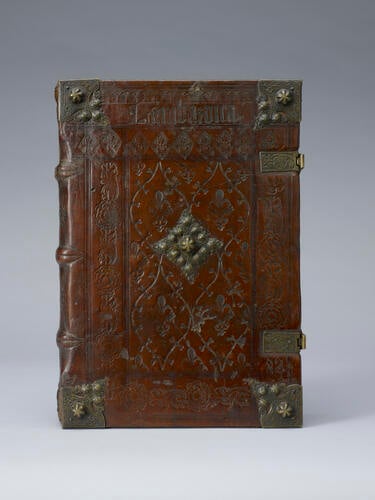-
1 of 253523 objects
Legenda aurea sanctorum, sive Lombardica historia 1 October 1482
[184] leaves | RCIN 1081254
-
The Golden Legend was a popular text in the medieval period. It is a hagiography, which is the name given to stories about the lives of Saints. We know that it was a popular text because there are more than a thousand surviving copies of this text in manuscript form. The format in which it was written can be described as being a catalogue of Saints’ lives, which to the eyes of a modern reader would be closer to an encyclopaedia of Saints.
The author Jacobus de Voragine was the archbishop of Genoa as well as a chronicler. He was born in Varagine and was a member of the Dominican order.
This edition was printed by Anton Koberger in Nuremberg. In the later 1400s Nuremberg was one of the major hubs for printing and Anton Koberger was one of the most successful booksellers and printers in Nuremberg, if not Germany, at this time. Koberger originally trained as a goldsmith but then changed to printing and selling books. At the height of his printing and bookselling business he employed over one hundred people and sold his books across Europe.
Provenance
Anno 1572 Den 14 Marty (=14. März) Enekomen vf / Vnnser bestalten Vestung Wolffenbüttel bey der / Heinrichsstatt auß dem Closter Woltinrode
Acquired by Queen Victoria -
Creator(s)
Acquirer(s)
-
Medium and techniques
[184] leaves
Category
Other number(s)
ISTC : Incunabula Short Title Catalogue – ISTC ij00103000RL acq. 1892-1919: Books added to Royal Library, Windsor Castle 1 January 1892 to 18 December 1919 – RL acq. 1892-1919 1 June 1892Alternative title(s)
Legenda aurea sanctorum, sive Lombardica historia / Jacobus de Voragine.
A contemporary binding from Nuremburg by the Münzer-meister. Full leather bound in brown calf, with blind tooling, front cover with central panel of foliate stems and fleur-de-lis, with border of triple roses (not Tudor roses) and foliage and repeated lozenge stamp with vase of flowers, above which title 'Lombardica'. Spine divided into four compartments, with each stamped with two triple roses. Back board with central compartment divided by X shape quadruple blind fillet lines, with each compartment stamped with a lozenge stamp of a dragon, with border of triple roses and foliage, the same as the front board. Brass corner furniture with bosses on both boards, central boss to both boards. Two clasps, attached to back board and hooking on front, with foliate design. Fore-edge bears handwritten title 'Legenda sanctor'. Book has been rebacked with new spine, but there is manuscript printers' waste used at spine which is visible inside back board. Spine repaired at head and tail with new leather. Clasps repaired with new leather.
Books were not always intended to be stored upright on a shelf, as this early binding shows. Before the development of gold tooling on bindings it was not feasible to mark the title of the book on the spine in a visible fashion. The title was therefore written on the text block, and the books were stored flat with the edge of the pages outermost.Place of Production
Nuremberg [Bavaria]
